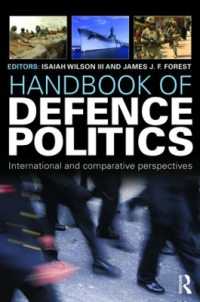- ホーム
- > 洋書
- > 英文書
- > Science / Mathematics
Full Description
Decision and Decision-maker in an Industrial Environment developed around the observation that two different decision-makers, faced with the same problem, may not make the same decision. The book proposes explanations for this, ranging from the wholly rational to the irrational, and analyzes different factors in decision-making, such as the intention of the decision-maker, the environment in which their decision is made or the process leading to decision-making.
While the common belief is that everything in an industrial environment stems from reasoned decisions, analysis of common practice shows that this is not always the case. This book offers an original perspective by presenting the decision making mechanism from the point of view of the decision maker and their handling of a specific decision-making problem.
To learn more about the decision-maker's motivations when faced with these situations, the authors provide a review of the history of decisionmaking and the major trends in decision-making theory. The concepts and methods are presented with illustrations based on the use of an MES, an industrial management software package.
Contents
Foreword ix
Preface xiii
Chapter 1 Decision and Decision Context 1
1.1 Introduction 1
1.2 A fleeting look at some of the great civilizations 5
1.2.1 Method of investigation 5
1.2.2 The ancient Near-East 6
1.2.3 Ancient Egypt 10
1.2.4 India 12
1.2.5 China 16
1.2.6 Ancient Greece 21
1.2.7 The Arab-Muslim world 25
1.2.8 The Western world 28
1.3 Conclusion 33
Chapter 2 Decisions: The Process 37
2.1 Introduction 37
2.2 Why a decision process? 40
2.3 The notion of process 43
2.4 Decision-making: rationality or intuition 44
2.5 The classical theory of rationality 46
2.5.1 The search for a numerical value 46
2.5.2 Fundamentals 47
2.5.3 Operational research 48
2.5.4 Game theory 52
2.5.5 Taking account of uncertainty: towards procedural rationality 53
2.5.6 A return to the decision process 56
2.5.7 Summary and analysis 60
2.6 Procedural rationality theory 62
2.6.1 The search for a satisfactory solution 62
2.6.2 The basics 64
2.6.3 The school of Herbert Simon 66
2.6.4 Extensions to Simon's process 74
2.6.5 Procedural rationality and artificial intelligence 83
2.6.6 A return to the decision process 84
2.6.7 Summary and analysis 87
2.7 Conclusion 89
Chapter 3 The Decision: The Multi-criteria Universe 91
3.1 Introduction 91
3.2 Comparing to be able to choose 93
3.2.1 Intuitive vision 93
3.2.2 In a single criterion universe 94
3.2.3 In a multi-criteria universe 94
3.3 The construction of MCDA 95
3.4 Vocabulary 98
3.4.1 Solutions 98
3.4.2 The criteria 101
3.4.3 Decision types 107
3.5 Ordering for comparison 111
3.5.1 Intuitive vision 111
3.5.2 The notion of preferences 112
3.5.3 Preferences and order relationships 114
3.6 The particular case of Pareto dominance 121
3.7 Summary 124
3.8 Conclusion 126
Chapter 4 The Decision: Methods 127
4.1 Introduction 127
4.2 Outranking 129
4.2.1 Principles 129
4.2.2 Condorcet's method 131
4.2.3 The ELECTRE III method 134
4.3 Aggregation 147
4.3.1 Principles 147
4.3.2 The Borda count method 150
4.3.3 The AHP method 152
4.3.4 The MACBETH method 168
4.4 Conclusion 187
Conclusion 189
References 193
Index 207








